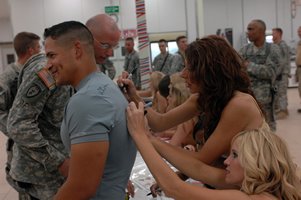
Two of the New Orleans Saintsations sign the shirt of San Juan, Puerto Rico, native, Sgt. 1st Class Carlos Cortes, Company A, 725th Brigade Support Battalion, 4th Brigade Combat Team (Airborne), 25th Infantry Division, during their visit to Forward Operating Base, Iraq, June 23. (Photo by Sgt. Marcus Butler)
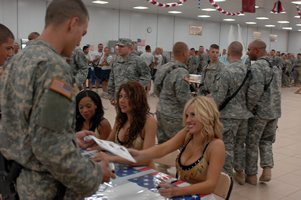
One of the Saintsations hands back a group photo signed by all of the Saintsations after their performance June 23 during their visit to Forward Operating Base Kalsu, Iraq. (Photo by Sgt. Marcus Butler)
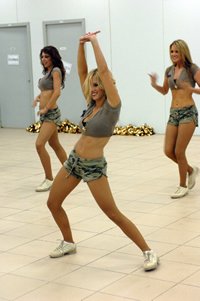
Saintsations sensational at FOB Kalsu
By Sgt. Marcus Butler, 4th Brigade Combat Team (Airborne), 25th Infantry Division
KALSU, Iraq – The New Orleans Saintsations were able to spread some cheer during their visit to Forward Operating Base Kalsu, Iraq, June 23.
The Saintsations partook in a meet-n-greet as well as performed a variety of dance routines and audience participation skits.
Arriving that morning, the Saintsations began their visit by walking around FOB Kalsu talking and joking with the servicemembers before their show began.
“We are so honored to be here today to perform for you,” said Dianne, one of the Saintsations. “We came here to support you, our troops, to show you that we love and appreciate everything that you do for us.”
“This event was a great morale booster for everyone,” said Sgt. 1st Class Carlos Cortes, 725th Brigade Support Battalion, 4th Brigade Combat Team (Airborne), 25th Infantry Division and San Juan, Puerto Rico, native. “From start to finish, the show was awesome, especially when the Saintsations called up people to dance.”
After the show, the Saintsations posed for photos and all sat down and signed pictures, calendars and even t-shirts to show the Soldiers how much they care.
“All of the Saintsations that visited FOB Kalsu came on their own accord. There was no one forcing them to come here, they all volunteered,” said Capt. Michael Schulte, 725th BSB, 4th Brigade Combat Team (Airborne), 25th Infantry Division.
To thunderous applause, the Saintsations exited stage left leaving behind wonderful memories and smiles on the crowd’s faces.
.
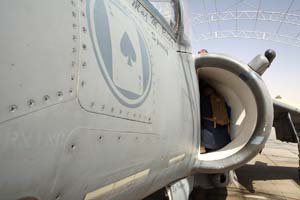
Cpl. Tom Mitsch, a powerline mechanic with Marine Attack Squadron 231, sands the blades on the intake of an AV-8B “Harrier” belonging to the “Ace of Spades” on the Al Asad flight line.
Story and photo by Cpl. Zachary Dyer
2nd Marine Aircraft Wing (FWD)
AL ASAD — A Marine on the ground in Iraq needs to be able to count on a friend or two. He has the Marine to the right, but he also has Marines flying a few thousand feet over head that he can count on.
The Marines of Marine Attack Squadron 231, known as the “Ace of Spades,” are making sure they do everything they can to provide the Marines outside the wire with the close air support they need.
Flying AV-8B “Harriers,” the Aces have been supporting their fellow Marines since they arrived aboard Al Asad in the middle of March.
“The Harrier’s role is to provide close air support to the Marines on the ground,” said Maj. Mark Riedy, the Aces’ executive officer. “Recently things have quieted down, so when we go out there we’re searching various points for enemy activity, suspicious activity, (Improvised Explosive Devices) and those types of things. We pass that information along to the Marines on the ground, and then if we have troops in contact we are there to support them.”
Since their arrival, the Aces have succeeded in adapting to the deployed environment and fulfilling their mission, according to Lt. Col. Brian Annichiarico, the VMA-231 commanding officer.
“I think the Marines have done fantastic,” said Annichiarico, a Dobbs Ferry, N.Y., native. “This is the first squadron deployment in a few years, and everybody was chomping at the bit to come. We tried to prepare them mentally as much as we could to come over here, and they have far exceeded my expectations. They’re just phenomenal.”
Previously, the Aces have deployed with Marine Expeditionary Units, and there are stark differences between a deployment with a MEU and a deployment as a whole squadron to Iraq.
Besides flying off a 13,000 foot runway instead of the flight deck of a ship, and the extreme heat, the Aces had to adjust to an increased operational tempo. The pilots of VMA-231 have flown an average of 40 hours per month during their deployment, which is about four times what they would fly back in the states, according to Riedy, an Allentown, Pa., native.
The Aces have flown almost 1,700 hours and have supported over 940 joint tactical air requests since they deployed to Al Asad.
Both Annichiarico and Riedy say they are proud of the way their Marines have adapted to their new environment and their new deployment.
“As long as they see us launching and dropping ordnance and coming back, they stay pretty motivated,” said Riedy. “We’ve been trying to make a habit out of telling them what we’re doing, showing them maps, showing them areas that we’re going to. Telling them that it’s not just about dropping bombs, that we’re out there providing support to the Marines.
It is not the work of just a few Marines that has made the squadron successful in Iraq, but the efforts of every person that allows the Aces to do what they do best, according to Annichiarico.
“You have a circle out there, and anywhere you touch the circle something will break down,” said Annichiarico. “If a maintainer doesn’t fix a jet or a helicopter, then that helicopter or jet can’t fly, and the guys on the ground don’t get the support. If they guys on the ground don’t get the support they need, then there may be additional risks that you accept, and so on and so forth. It never ceases to amaze me how that whole chain works. The reason it works so well is because of the individual efforts of the Marines out there.”











 …….Thank you Jack for sending the article to me.
…….Thank you Jack for sending the article to me.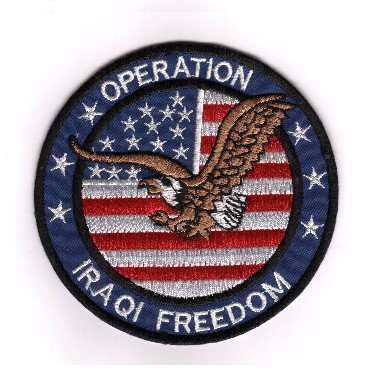



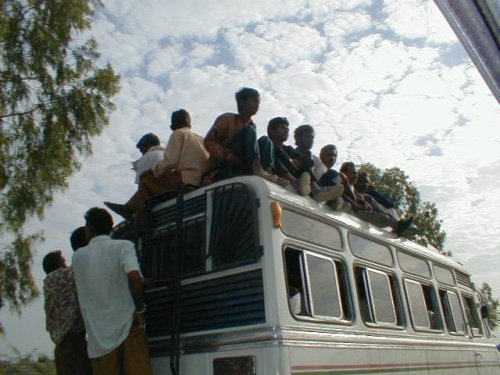
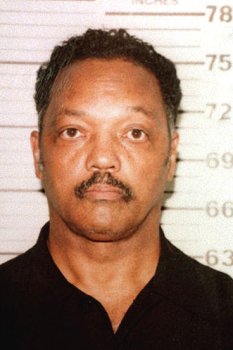



Recent Comments